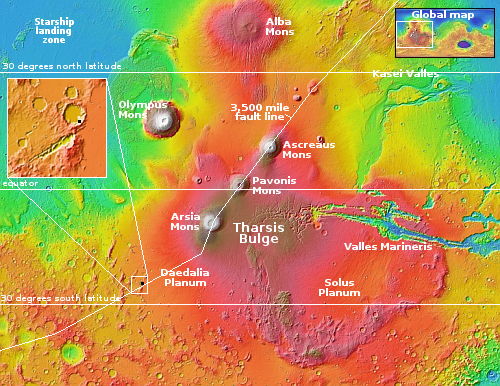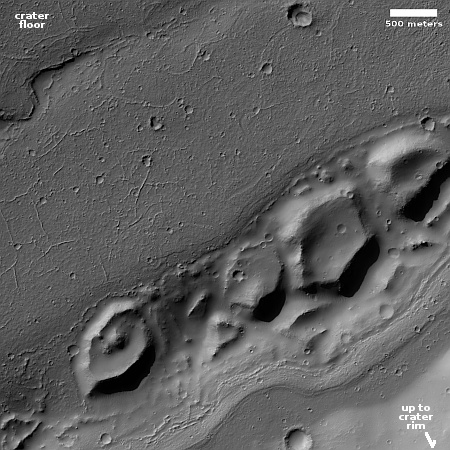Almost all of Mars’ geological mysteries in one spot
Cool image time! The picture to the right, rotated, cropped, reduced, and sharpened to post here, was taken on June 30, 2023 by the high resolution camera on Mars Reconnaissance Orbiter (MRO). The scientists label it “Mesas in shallow trough,” but that is only describes a small part of what can be seen here, as I interpret it.
The picture itself shows a small portion of the floor of an unnamed 32-mile-wide crater, with the crater’s southeast interior rim beginning its rise in the lower right. First, note the meandering hollow in the upper left, suggesting some past flow. Second, note the pattern of small ridges on the flat crater floor, suggesting some past drying process that left cracks that later filled with material that formed the ridges at a later time. Third, the mesas themselves suggest chaos terrain, often formed on Mars in connection with glacial flows. Fourth, note that the trough which holds the mesas is on the edge of the crater floor, suggesting the trough and mesas mark the erosion that once occurred at the edge of some material, possibly ice, that once filled that floor.
The trough and small meander also signify something far larger that can only be seen when we zoom out.

The black dot on the overview map to the right marks this location, in the southwest of the lava plain dubbed Daedalia Planum and right on the 3,500-mile-long fault line that runs through three of Mars’ biggest volcanoes and expresses itself to the northeast and southwest as one crack or many parallel cracks.
Both that meander and trough align with this faultline, which also cuts through the crater’s rims, telling us whatever event caused the fault occurred after the impact that formed the crater. The floor of the crater is also very smooth and flat, which suggests it was later flooded by the lava that covered the entire Tharsis Bulge of volcanoes. That flooding in turn tells us that the pattern of small ridges were likely formed when the surface of that lava solidified. In doing so it cracked, allowing still molten lava underground to push up through the cracks to form those ridges.
Though this crater is in the dry equatorial regions where so far orbital data has as yet found no evidence of near surface ice, the mesas suggest that glacial ice once existed here, which in turn suggests the affect of Mars’ many climate cycles.
Thus, this small spot on Mars provides evidence some of the red planet’s most dramatic geological history, beginning with the early heavy bombardment of asteroids in the very early solar system four billion years ago that formed the planets while leaving innumerable craters behind. Next came the event (possibly a giant impact on the opposite side of Mars) that cracked the planet and formed those southwest-to-northeast fault lines, which in turn allowed for the long release of magma that formed the giant volcanoes and flooded this region with lava.
Finally, the endless Martian climate cycles caused by the large changes in the planet’s rotatational tilt, from 11 to 60 degrees, helped bring and take ice to this location time after time, each cycle eroding the material in the trough to form the mesas.
That’s the rough story, based on the sparse and coarse orbital data presently available. Until we can get to Mars and study its entire surface in detail, this hypothesized geological history is only a rough guess, and should be taken with a great deal of skepticism.
On Christmas Eve 1968 three Americans became the first humans to visit another world. What they did to celebrate was unexpected and profound, and will be remembered throughout all human history. Genesis: the Story of Apollo 8, Robert Zimmerman's classic history of humanity's first journey to another world, tells that story, and it is now available as both an ebook and an audiobook, both with a foreword by Valerie Anders and a new introduction by Robert Zimmerman.
The print edition can be purchased at Amazon or from any other book seller. If you want an autographed copy the price is $60 for the hardback and $45 for the paperback, plus $8 shipping for each. Go here for purchasing details. The ebook is available everywhere for $5.99 (before discount) at amazon, or direct from my ebook publisher, ebookit. If you buy it from ebookit you don't support the big tech companies and the author gets a bigger cut much sooner.
The audiobook is also available at all these vendors, and is also free with a 30-day trial membership to Audible.
"Not simply about one mission, [Genesis] is also the history of America's quest for the moon... Zimmerman has done a masterful job of tying disparate events together into a solid account of one of America's greatest human triumphs."--San Antonio Express-News
Cool image time! The picture to the right, rotated, cropped, reduced, and sharpened to post here, was taken on June 30, 2023 by the high resolution camera on Mars Reconnaissance Orbiter (MRO). The scientists label it “Mesas in shallow trough,” but that is only describes a small part of what can be seen here, as I interpret it.
The picture itself shows a small portion of the floor of an unnamed 32-mile-wide crater, with the crater’s southeast interior rim beginning its rise in the lower right. First, note the meandering hollow in the upper left, suggesting some past flow. Second, note the pattern of small ridges on the flat crater floor, suggesting some past drying process that left cracks that later filled with material that formed the ridges at a later time. Third, the mesas themselves suggest chaos terrain, often formed on Mars in connection with glacial flows. Fourth, note that the trough which holds the mesas is on the edge of the crater floor, suggesting the trough and mesas mark the erosion that once occurred at the edge of some material, possibly ice, that once filled that floor.
The trough and small meander also signify something far larger that can only be seen when we zoom out.

The black dot on the overview map to the right marks this location, in the southwest of the lava plain dubbed Daedalia Planum and right on the 3,500-mile-long fault line that runs through three of Mars’ biggest volcanoes and expresses itself to the northeast and southwest as one crack or many parallel cracks.
Both that meander and trough align with this faultline, which also cuts through the crater’s rims, telling us whatever event caused the fault occurred after the impact that formed the crater. The floor of the crater is also very smooth and flat, which suggests it was later flooded by the lava that covered the entire Tharsis Bulge of volcanoes. That flooding in turn tells us that the pattern of small ridges were likely formed when the surface of that lava solidified. In doing so it cracked, allowing still molten lava underground to push up through the cracks to form those ridges.
Though this crater is in the dry equatorial regions where so far orbital data has as yet found no evidence of near surface ice, the mesas suggest that glacial ice once existed here, which in turn suggests the affect of Mars’ many climate cycles.
Thus, this small spot on Mars provides evidence some of the red planet’s most dramatic geological history, beginning with the early heavy bombardment of asteroids in the very early solar system four billion years ago that formed the planets while leaving innumerable craters behind. Next came the event (possibly a giant impact on the opposite side of Mars) that cracked the planet and formed those southwest-to-northeast fault lines, which in turn allowed for the long release of magma that formed the giant volcanoes and flooded this region with lava.
Finally, the endless Martian climate cycles caused by the large changes in the planet’s rotatational tilt, from 11 to 60 degrees, helped bring and take ice to this location time after time, each cycle eroding the material in the trough to form the mesas.
That’s the rough story, based on the sparse and coarse orbital data presently available. Until we can get to Mars and study its entire surface in detail, this hypothesized geological history is only a rough guess, and should be taken with a great deal of skepticism.
On Christmas Eve 1968 three Americans became the first humans to visit another world. What they did to celebrate was unexpected and profound, and will be remembered throughout all human history. Genesis: the Story of Apollo 8, Robert Zimmerman's classic history of humanity's first journey to another world, tells that story, and it is now available as both an ebook and an audiobook, both with a foreword by Valerie Anders and a new introduction by Robert Zimmerman.
The print edition can be purchased at Amazon or from any other book seller. If you want an autographed copy the price is $60 for the hardback and $45 for the paperback, plus $8 shipping for each. Go here for purchasing details. The ebook is available everywhere for $5.99 (before discount) at amazon, or direct from my ebook publisher, ebookit. If you buy it from ebookit you don't support the big tech companies and the author gets a bigger cut much sooner.
The audiobook is also available at all these vendors, and is also free with a 30-day trial membership to Audible.
"Not simply about one mission, [Genesis] is also the history of America's quest for the moon... Zimmerman has done a masterful job of tying disparate events together into a solid account of one of America's greatest human triumphs."--San Antonio Express-News


